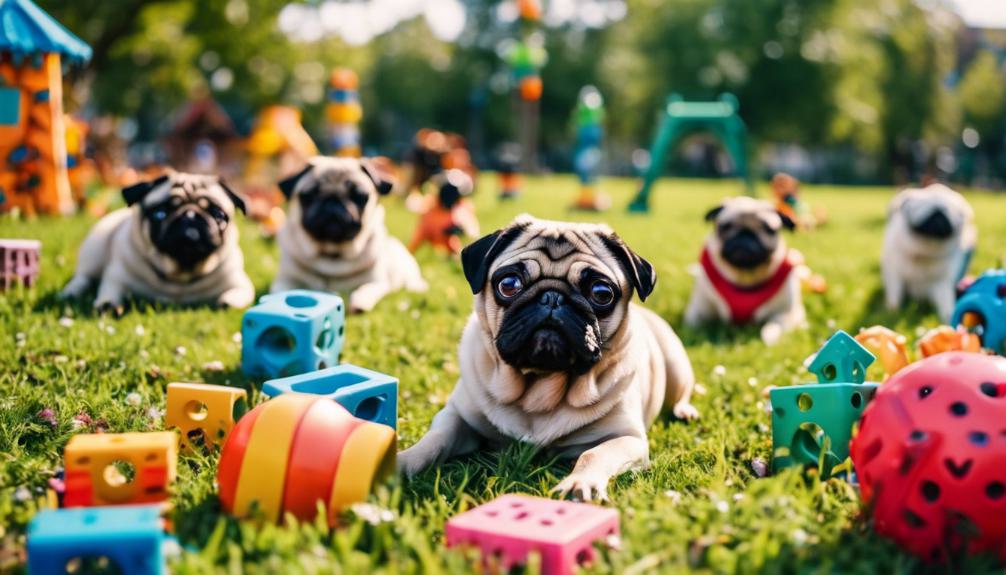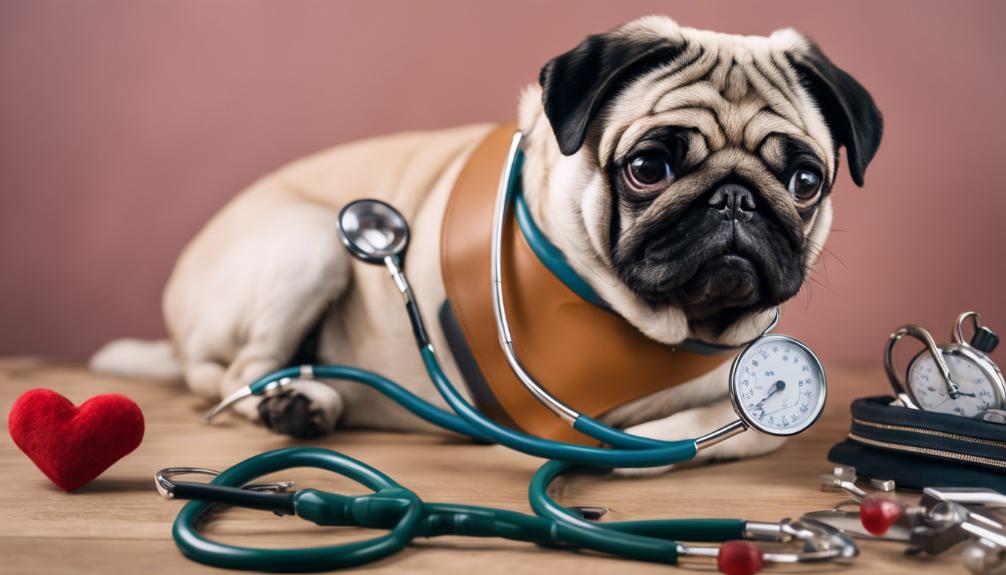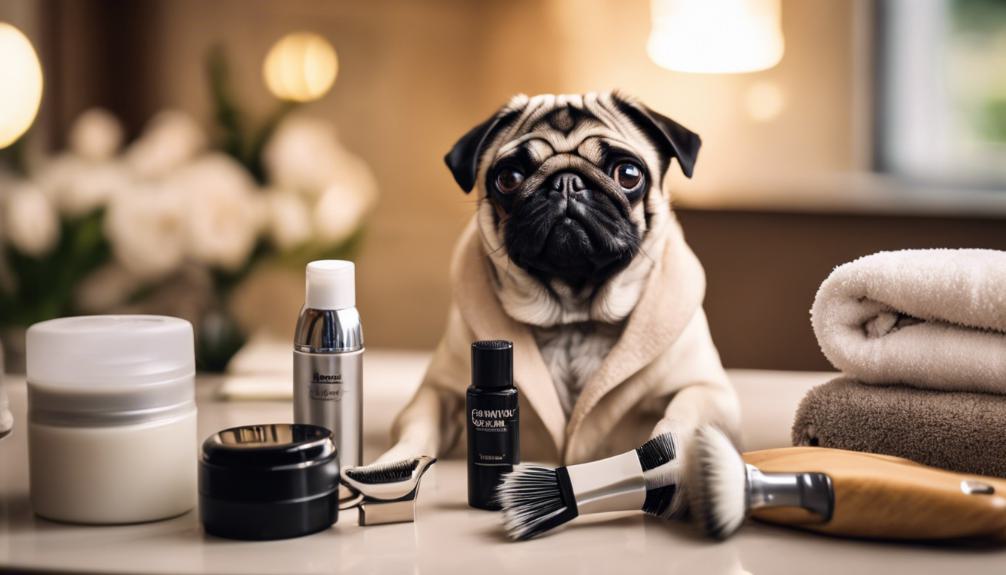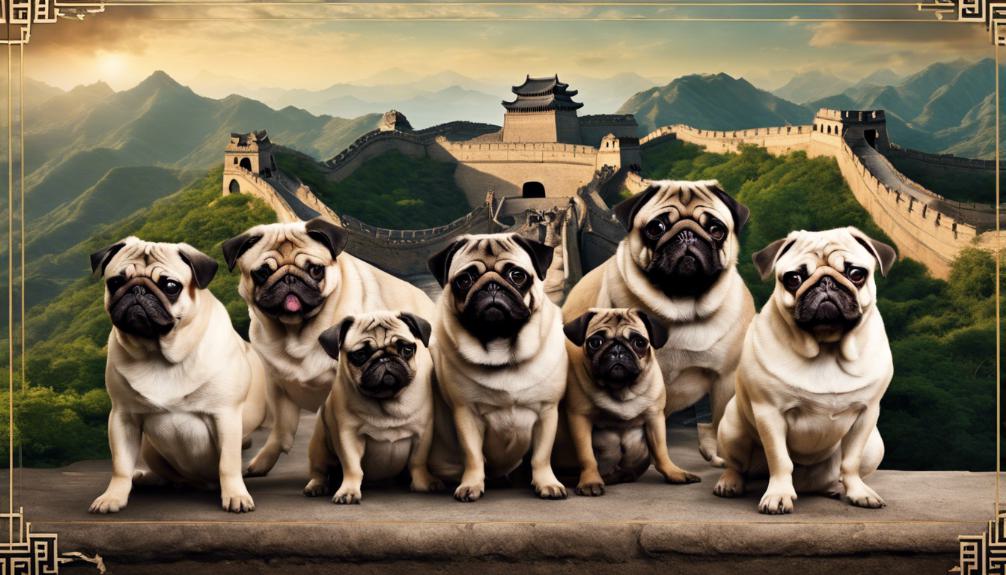Pug Dog Breed: History, Personality Traits, and Care
‘Pugs, beloved by Chinese emperors and European royalty, are known for their companionable nature and playful demeanor. At 14 to 18 pounds, they’re affectionate, friendly, but can be quite stubborn. You’ll want to offer them early socialization and consistent training. Their grooming needs include regular cleaning of their facial wrinkles, and keep in mind their susceptibility to heatstroke. Hence, offer them a cool resting place in warmer conditions. Monitor their diet, as they’re prone to obesity. If you’re keen to know more about Pugs, you’re in the perfect place – there’s a wealth of information simply waiting for your discovery!’
Origin and Evolution of Pugs
Let’s explore the fascinating origin and evolution of Pugs, a breed that started as prized companions to Chinese emperors and later captured the hearts of European royalty in the 1500s.
Pugs have a rich history in China, cherished as companions by emperors and the elite. This affection wasn’t contained to just one continent, it soon spread to Europe. The charm of these compact canines won over European royalty, becoming treasured pets within noble households.
Pugs truly embody the Latin phrase ‘Multum in parvo’, which means ‘a lot in a little’. They were recognized by the American Kennel Club in 1885, further cementing their prestige. Throughout different cultures and time periods, Pugs have remained beloved companions, a tribute to their enduring appeal.
Pugs in Historical Context
Delving into the historical context of Pugs, you’ll find their roots deeply embedded in Chinese and European royal circles. Originating in China, Pugs were treasured by emperors as loyal, affectionate companions. They’ve been loved and adored for centuries, their charming demeanor never failing to captivate hearts.
By the 1500s, European royalty had also succumbed to their charm. The Latin phrase ‘Multum in parvo,’ aptly describes these dogs – a lot in a little. Their small size belies their big personalities.
Fast forward to 1885, the American Kennel Club recognized the breed, further cementing their status. Despite the passage of time, Pugs remain cherished companions, their legacy of loyalty and affection enduring.
Unique Physical Characteristics

Sporting a distinctive square-like body and substantial legs, a Pug’s physical characteristics are as unique as their personality. Their big round heads sit atop this compact body, adorned with deep forehead wrinkles that add to their charm. The short muzzle is another standout feature, framed by their facial wrinkles.
The prominent eyes, dark, shiny, and slightly protruding, give them an inquisitive look, contributing to their endearing expression. Their unique physical characteristics aren’t just for show, they’re a symbol of the breed’s rich history. Despite their small size, they carry a weight of around 14 to 18 pounds, standing at a height of 10 to 11 inches.
These characteristics make Pugs unmistakable and adored by many.
Understanding Pug Personality Traits
Moving from their distinct physique, it’s equally important to understand the temperament of Pugs, a trait that truly sets them apart. Pugs are affectionate, playful, and known to be the clowns of the canine world. They form strong bonds with their owners and are friendly with other pets. A table below illustrates their key personality traits:
| Trait | Description |
|---|---|
| Affectionate | Pugs are known for their loving nature |
| Playful | Their lively demeanor often entertains |
| Clownish | They’re amusing with their antics |
| Stubbornness | Despite intelligence, they can be stubborn |
Their stubbornness can require patient training techniques. Early socialization helps shape their behavior. Despite any stubborn streaks, Pugs are intelligent and their friendly, playful nature makes them a joy to have around.
Social Behavior of Pugs

Now, let’s talk about how pugs behave socially.
You’ll find that they’ve a strong affinity for human interaction, often showing a playful nature that’s hard to resist.
Their interactions with other dogs can be equally charming, but remember, early socialization is key to nurturing their positive social manners.
Pugs and Human Interaction
You’ll find that Pugs, with their friendly and loving nature, relish human interaction and form strong bonds with their owners. They’re social, affectionate, and thrive in indoor living conditions, making them excellent companions.
As a Pug owner, you’ll enjoy:
- Their constant companionship: Pugs are always by your side, offering their love and loyalty.
- Interaction with guests: Pugs generally get along well with visitors, adding to their social appeal.
- Excellent family pets: Their friendly nature and affectionate temperament make them great with children and other family members.
Interaction With Other Dogs
While Pugs certainly adore their human companions, they’re also known for getting along splendidly with other dogs. Their social nature and friendly disposition make them excellent candidates for canine companionship.
You’ll often notice their playful behavior, which plays an essential role in forming strong bonds with their furry friends. Proper socialization, started early, can further enhance these interactions, helping your Pug to navigate the complexities of doggy dynamics successfully.
Their laid-back demeanor makes them adaptable and well-suited for multi-dog households. In such environments, they’re likely to thrive, enjoying the company of other dogs and contributing to a harmonious household. If you’re considering adding another dog to your family, a Pug’s sociable and amicable nature could make them a perfect choice.
Pugs Playful Nature
With their charming nature and clown-like antics, Pugs are known to be not only great companions but also engaging entertainers, often able to turn even a mundane day into a joyful experience. Their social behavior is quite affectionate and loyal, reflecting in their interactive playtime.
- Playful: They adore playing and their expressive faces are a delight to watch during these moments.
- Charming: Their clown-like antics add to their charm, making them the heart of any gathering.
- Active: Despite their small size, Pugs require moderate exercise, ensuring they stay healthy and happy.
Health Concerns and Lifespan

Now, let’s talk about your Pug’s health and lifespan.
You can expect your Pug to live around 13 to 15 years, but their health issues such as eye problems, allergies, and dental issues, could affect this.
Regular vet visits are key to catching these issues early and ensuring your Pug lives a long, healthy life.
Pug Health Issues
Diving into the health issues of Pugs, it’s important to note that they typically live between 13 to 15 years but are susceptible to several health concerns including brachycephalic airway syndrome, eye problems, allergies, skin infections, and dental issues.
As brachycephalic dogs, Pugs often struggle with breathing and can develop severe issues requiring surgery. Eye problems such as entropion are common too. In addition, they’re prone to:
- Allergies: These can cause skin infections and chronic skin problems.
- Skin Infections: Regular vet checks can identify and treat these early.
- Dental Issues: Regular dental care is vital for Pugs.
Being aware of these health issues helps you provide the best care possible for your Pug, ensuring a happy and healthy life.
Pug Lifespan Factors
In relation to your Pug’s lifespan, several factors are significant, including common health concerns such as brachycephalic airway syndrome, eye problems, allergies, skin issues, and dental problems. Regular vet check-ups are critical to identify and manage these health concerns early.
Additionally, your Pug’s diet plays an integral role in their lifespan. A balanced diet not only helps maintain a healthy weight, but it also supports overall well-being. Pugs are prone to obesity, which can exacerbate health issues and potentially shorten their lifespan. So, make sure your furry friend gets the right nutrition and portion sizes.
Pugs Nutritional Needs
To keep your pug healthy and prevent obesity, it’s essential to provide a high-quality, balanced diet, including two measured meals a day. Controlling your pug’s calorie intake is important, and don’t forget to monitor their treat consumption closely as it could lead to weight gain.
Remember that your pug’s nutritional needs can vary based on:
- Age: Puppies have different needs than adults or seniors.
- Activity level: More active pugs need more calories.
- Health: Certain health conditions may require a specialized diet.
Hydration is also significant. Always make sure that fresh, clean water is available for your pug to maintain proper hydration. With the right diet and care, you can safeguard your pug’s health and happiness.
Grooming Essentials for Pugs

Let’s get your Pug looking its best!
From coat maintenance to bathing routines, there’s quite a bit you’ll need to know.
We’ll start with the right tools and techniques to make sure your Pug’s fur and skin stay healthy and clean.
Pug Coat Maintenance
Ever wondered how to keep your Pug’s coat in top condition? Coat maintenance for pugs involves more than just managing shedding with daily brushing. Here’s your three-step guide to Pug coat care:
- Regular Cleaning: Pay special attention to their facial wrinkles and skin folds. This prevents skin infections, which Pugs are prone to.
- Ear and Nail Care: Regularly check and clean their ears to prevent ear infections. Nail trimming is also key to their overall health.
- Dental Care: Don’t forget about their teeth! Daily brushing and a proper diet are essential to prevent dental issues.
Essential Grooming Tools
Stocking up on the essential grooming tools for your Pug can greatly enhance their coat health and overall well-being. A slicker brush is a must-have. It removes loose hair and prevents matting, keeping your Pug’s coat smooth and shiny.
A grooming glove is another useful tool for gentle brushing and massaging. For dental hygiene, a dog-specific toothbrush and toothpaste are necessary. You’ll also need nail clippers or a nail grinder to maintain your Pug’s nails at a healthy length.
Bathing Your Pug
When it comes to grooming essentials for Pugs, bathing your furry friend every 2-4 weeks is essential for maintaining their hygiene and skin health. Regular baths keep Pugs looking and feeling their best, and help control shedding.
Here are some tips for bathing your Pug:
- Use a gentle dog shampoo to avoid skin irritation and dryness.
- Pay special attention to cleaning their facial wrinkles. Remember to thoroughly dry these areas afterward to prevent infections.
- Avoid getting water in their ears as this can lead to problems.
It’s not just about cleanliness; regular grooming sessions can be a bonding experience. So, get your Pug bathed, keep them healthy, and embrace the joy of grooming.
Training and Exercising Pugs

Training your Pug is relatively easy thanks to their intelligence and desire to please their owners. Early socialization and puppy classes can help shape well-rounded Pug behavior.
In terms of exercise, Pugs require moderate daily exercise to stave off obesity, despite not being overly active. Short walks and play sessions are enough to keep your Pug healthy and happy. However, caution is necessary in hot weather.
Pugs are prone to heatstroke due to their short snouts and can struggle in warm conditions. So, avoid strenuous activities during hot weather, make sure they’ve access to fresh water, and provide a cool place to rest.
Therefore, with the right approach, you can make sure your Pug is both well-trained and well-exercised.
Tips for Pug Owners
As a Pug owner, it’s crucial that you’re familiar with a few essential tips to guarantee your furry friend stays healthy and happy.
- Early Socialization and Training: Implement gentle training methods from a young age for ideal behavior. Early socialization helps your Pug adjust to various situations and environments.
- Maintain Healthy Weight: Monitor your Pug’s calorie intake to prevent obesity, a common issue in this breed. Ensure they get regular, but not strenuous, exercise.
- Health and Hygiene: Regularly clean your Pug’s facial wrinkles and skin folds to avoid infections. Stay alert to common health issues like brachycephalic airway syndrome and eye problems.
Frequently Asked Questions
What Traits Were Pugs Bred For?
You’re asking about the traits pugs were bred for. They weren’t bred for specific tasks but for companionship. Pugs are known for their affectionate, friendly, and loving nature; they’ve got big personalities in small packages.
What Is the History of the Pug?
You’re curious about the history of Pugs? They originated in China, were loved by European nobility, and introduced to the U.S. post-Civil War. The AKC recognized them in 1885, and they’re currently the 28th most popular breed.
What Are Typical Pug Behaviours?
You’ll find pugs to be affectionate, charming, and often quite playful. They’re known for their clownish antics and strong bonds with owners. They’re friendly with others, but can be a bit stubborn. Early socialization’s important.
Are Pugs High Maintenance?
Yes, you’d consider pugs high maintenance. They need daily grooming due to shedding, regular wrinkle cleaning, consistent dental care, and a monitored diet to avoid obesity. Also, they’re sensitive to heat due to their brachycephalic nature.
Conclusion
So, you’re now well-versed in all things Pug. From their unique history and physical traits to their playful personality and grooming needs, Pugs are truly a breed apart.
Remember, a well-fed, well-groomed, and well-exercised Pug is a happy Pug. So, listen to their needs, and you’re sure to have a loyal companion.
With their endearing qualities, it’s no wonder they’ve won the hearts of many. Now, go forth and enjoy the delightful company of your Pug!

